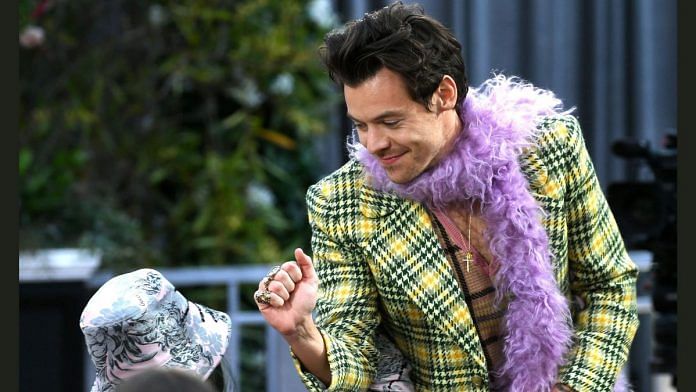The 1990s are having a moment in consumer culture. But with the world in the grip of rampant inflation, and Britain enduring a summer of discontent, it feels like we’re living in a 1970s economy.
Nineties nostalgia has been building for some time. Bold logos, which disappeared after the financial crisis, have made a splashy comeback. Burberry Group Plc has even revived its trademark black, white, tan and red check, a rehabilitation for the plaid worn by Oasis’s Liam Gallagher in the 1995 music video for “Wonderwall.” Y2K, inspired by the outfits of the mid-90s to early 2000s, is now a fashion category in its own right.
But lately, the clamor for all things 90s, particularly the earlier years, has intensified.
In fashion, the smiley face, a potent symbol of Britain’s late ‘80s and early ‘90s rave culture, has been freshly emblazoned on everything from socks to designer handbags to home furnishings. The Clarks Wallabee boot, a favorite among ravers and the Manchester band scene, was the sixth-hottest men’s item in the first quarter of this year, according to the Lyst Index. Bucket hats, which have had a luxe makeover, have been high on previous Lyst Indexes, which measure searches on the fashion platform and other sites as well as social media engagement.
And just this week, Beyonce released her single “Break My Soul,” with house music’s characteristic bouncing beats and piano riffs. Some of the tracks on Drake’s new album “Honestly, Nevermind” are also reminiscent of the era’s dance tunes.
It may be fear of recession that’s driving today’s obsession with all things early ‘90s. The period was characterized by a dismal economy and large-scale unemployment, although Beyonce’s track is more an ode to the Great Resignation than ringing alarm bells on redundancies. Caution on the global economy is certainly becoming more prevalent. The New York Federal Reserve’s latest forecast puts the possibility of recession, or a “hard landing,” at 80%.
And yet this anxiety comes against the backdrop of joy at being able to socialize again. That may be one reason why the euphoria of the early ‘90s dance scene is resonating.
2022: so much house music, so few homes
— Sheila Mikailli (@SheilaMikailli) June 22, 2022
As recession warning signs flash, the immediate problem is inflation, at a 40-year high on both sides of the Atlantic. As Mohamed A. El-Erian has pointed out, the current situation mirrors the 1970s, with its winter of discontent, stagflation, real wage resistance and labor strikes. The similarities don’t stop there: The S&P 500 Index is on track for its worst first half since 1970, while the prospect of gas rationing in Europe this winter sounds like the previous era’s blackouts.
There are some signs of the decade making its way into consumer culture, too.
Gucci creative director Alessandro Michele has long incorporated 1970s design codes, such as wider trousers and lapels, as well as bold prints. But there are signs that the more louche, bohemian aesthetic is gaining traction.
Just look at the outfits worn recently by Harry Styles, including many from the Kering SA-owned brand. This week, Gucci unveiled a collection with Styles with distinctly 70s undertones.
Other relics from the era have been popping up, including wide legged jeans, crochet and patchwork. Online searches for rattan bedroom furniture at British department store John Lewis are double what they were a year ago. There are even some 1970s and 1990s crossover hits — platform shoes (high on the Lyst Index) and clogs can be found everywhere from Versace and Hermes International to Christian Dior’s collaboration with Birkenstock.
Meanwhile, world-famous music group Abba is making a comeback with their 2022 Voyage tour. They’ll perform as digital avatars, giving the 1970s a very 21st-century twist.
Consumer-facing companies expect the economic outlook to deteriorate this autumn, as energy costs bite and pandemic savings are depleted by a summer of travel. It will be worth watching whether any more ‘70s-era trends crop up in stores, restaurants and on streaming services. Flares and fondue, anyone?
Perhaps consumers’ reluctance to embrace the period as much as the ‘90s and early 2000s is because the ‘70s are simply the decade that style forgot. Even today, fashion looks inspired by the era are tricky to pull off. What’s more, for Gen Z, the ‘90s represent an almost mythical happy place, before the perils of social media. That might explain why they want to go back there rather than the ‘70s. Price hikes and power cuts are far less fun.
Wearing multiple sweaters to keep warm this winter and having to shop for the cheapest toilet paper in Lidl will be bad enough. The prospect of doing so in a shiny, bell-bottomed jumpsuit is even more horrifying. -Bloomberg
Also read: Harry Styles collaborates with Gucci, announces new collection






